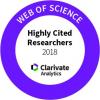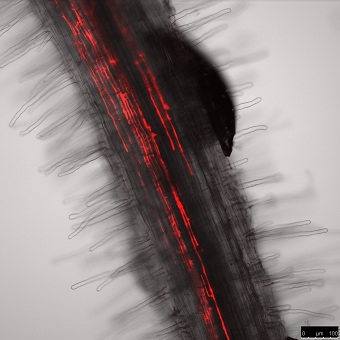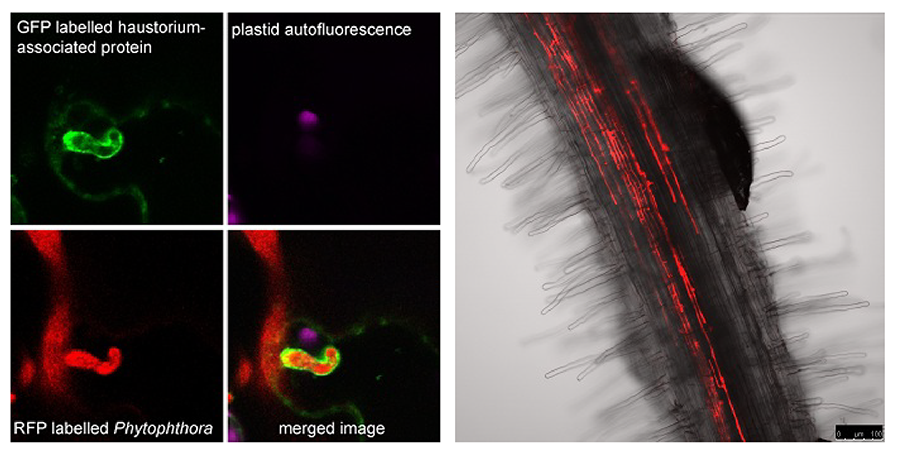Sebastian Schornack
Research Group Leader
Sainsbury Laboratory
University of Cambridge
47 Bateman Street
Cambridge CB2 1LR
Email: sebastian.schornack@slcu.cam.ac.uk
Office Phone: 01223 761145
Research Interests
Plants constantly engage in interactions with microbial organisms. These interactions can either be detrimental such as those with the economically relevant fungus-like oomycete Phytophthora infestans, the causal agent of the Irish Potato Famine or beneficial to supply phosphate such as in symbiotic interactions with mycorrhizal fungi that occur in most plant species.
Both, pathogenic and mutualistic symbioses follow structurally similar developmental processes to establish intracellular interfaces. It is generally accepted that both, plants and microorganisms contribute to the formation of dedicated accommodation structures. However, we know little about the underlying molecular mechanisms that drive differentiation of host cells and tissues to form intracellular interfaces.
The Schornack group aims to characterize the extent to which beneficial and detrimental microorganisms employ similar plant developmental processes for colonization. To this end we plan to assess the overlap between Mycorrhiza processes and root infection by the biotrophic pathogen Phytophthora palmivora and will characterize genetic elements with common functions. Furthermore, we will elucidate the role of microbial effectors for development of plant cells into intracellular accommodation structures. This work will reveal the boundaries between symbiosis and pathogenesis and will provide novel insights into plant development driven by biotic cues.
Selected Recent Publications
Timoneda A, Yunusov T, Quan C, Gavrin A, Brockington SF, Schornack S (2021) MycoRed: Betalain pigments enable in vivo real-time visualisation of arbuscular mycorrhizal colonisation. PLoS Biol 19(7): e3001326. https://doi.org/10.1371/journal.pbio.3001326
Carella, P., Gogleva, A., Tomaselli, M., Alfs, C., and Schornack, S. (2018) Phytophthora palmivora establishes tissue-specific intracellular infection structures in the earliest divergent land plant lineage. PNAS (Online Early: https://doi.org/10.1073/pnas.1717900115) Previously on bioRxiv (2017, Pre-Print). doi: https://doi.org/10.1101/188912. Watch the video about this research.
Evangelisti E., Gogleva A., Hainaux H., Doumane M., Tulin F., Quan C., Yunusov T., Floch K., Schornack S. (2017) Time-resolved dual transcriptomics reveal early induced Nicotiana benthamiana root genes and conserved infection-promoting Phytophthora palmivora effectors. BMC Biol. https://doi.org/10.1186/s12915-017-0379-1
Rey T., Chatterjee A.,Buttay M., Toulotte J., Schornack S. (2014) Medicago truncatula symbiosis mutants affected in the interaction with a biotrophic root pathogen. New Phytol. https://doi.org/10.1111/nph.13233
Wang E., Schornack S., Marsh J.F., Gobbato E., Schwessinger B., Eastmond P., Schultze M., Kamoun S., Oldroyd G.E. (2012) A Common Signaling Process that Promotes Mycorrhizal and Oomycete Colonization of Plants. Curr Biol. 22(23). https://doi.org/10.1016/j.cub.2012.09.043
Bozkurt, T.O.*, Schornack, S.*, Win, J., Shindo, T., Oliva, R., Cano, L.M., Jones, A.M.E., Huitema, E., van der Hoorn, R.A.L., Kamoun, S. (2011) Phytophthora infestans effector AVRblb2 prevents focal secretion of a plant immune protease, Proc Natl Acad Sci USA 108(51), * shared first authors https://doi.org/10.1073/pnas.1112708109
Chaparro-Garcia A., Wilkinson R.C., Gimenez-Ibanez S., Findlay K., Coffey M.D., Zipfel C., Rathjen J.P., Kamoun S.*, Schornack S.* (2011) The Receptor-Like Kinase SERK3/BAK1 Is Required for Basal Resistance against the Late Blight Pathogen Phytophthora infestans in Nicotiana benthamiana. PLoS ONE 6(1). * shared corresponding authors https://doi.org/10.1371/journal.pone.0016608
Schornack S.*, van Damme M.*, Bozkurt T.O., Cano L.M., Smoker M., Thines M., Gaulin E., Kamoun S., Huitema E. (2010): Ancient class of translocated oomycete effectors targets the host nucleus. Proc Natl Acad Sci USA 107(40). * shared corresponding authors https://doi.org/10.1073/pnas.1008491107
Selected reviews
Carella, P., and Schornack, S. (2017) Manipulation of bryophyte hosts by pathogenic and symbiotic microbes. Plant and Cell Physiology, pcx182, https://doi.org/10.1093/pcp/pcx182
Fawke, S., Doumane, M., Schornack, S. (2015): Oomycete Interactions with Plants: Infection Strategies and Resistance Principles, Microbiol Mol Biol Rev. https://doi.org/10.1128/mmbr.00010-15
Rey T., Schornack S. (2013): Interactions of beneficial and detrimental root-colonizing filamentous microbes with plant hosts. Genome Biol. 14(6). Review. https://doi.org/10.1186%2Fgb-2013-14-6-121
Schornack S., Moscou M.J., Ward E.R., Horvath D.M. (2013): Engineering Plant Disease Resistance Based on TAL Effectors. Annu Rev Phytopathol. 51. Review. https://doi.org/10.1146/annurev-phyto-082712-102255
Schornack S., Huitema E., Cano L.M., Bozkurt T.O., Oliva R., Van Damme M., Schwizer S., Raffaele S., Chaparro-Garcia A., Farrer R., Segretin M.E., Bos J., Haas B.J., Zody M.C., Nusbaum C., Win J., Thines M., Kamoun S. (2009): Ten things to know about oomycete effectors. Mol Plant Pathol. 10(6). Review. https://doi.org/10.1111/j.1364-3703.2009.00593.x



